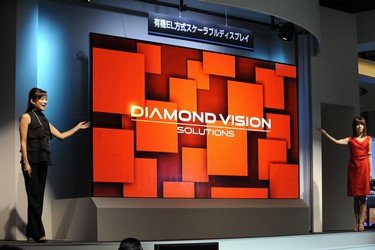Mitsubishi to start selling the 100" Diamond Vision OLED displays on September 21st
Mitsubishi Electric says that they will start selling the Diamond Vision OLED displays in 100" and above sizes on September 21st. The Diamond Vision (announced back in October 2009) is a modular displays for indoor use. Each module is 384mx384mm, with 128x128 resolution. Each pixel is about 3mm in size, you need to view the displays from at least two meters away.
 155-inch Diamond-Vision prototype
155-inch Diamond-Vision prototypeThe Diamond Vision is bright (1,200cd/m²) and has a good contrast (twice as better as LED, says Mitsubishi) - so it can be used in brightly-lit areas such as airports or stations. The OLEDs were jointly developed by Mitsubishi and Pioneer.






